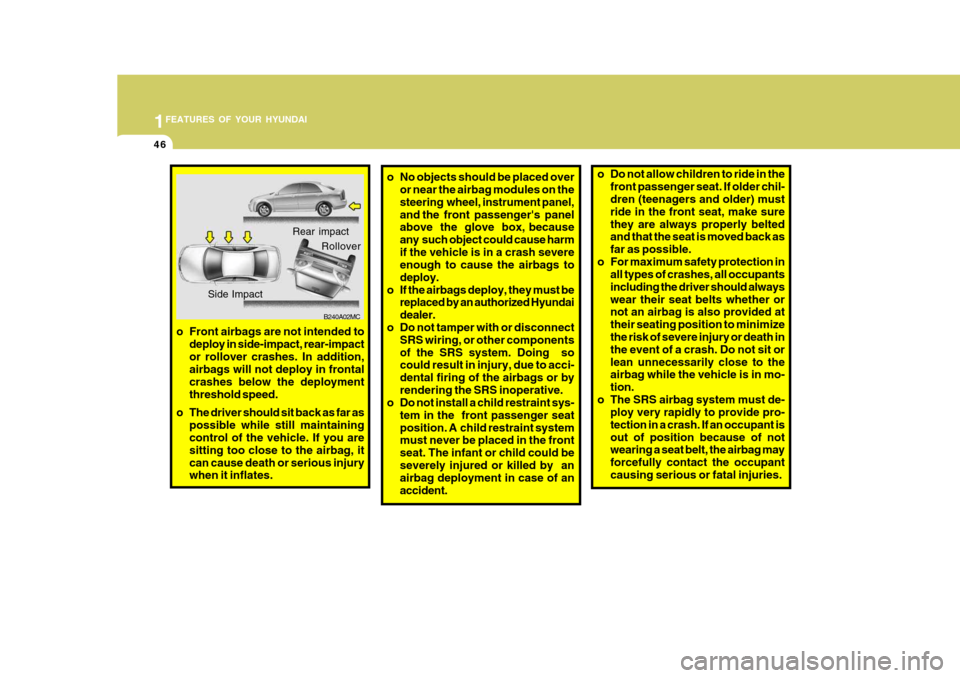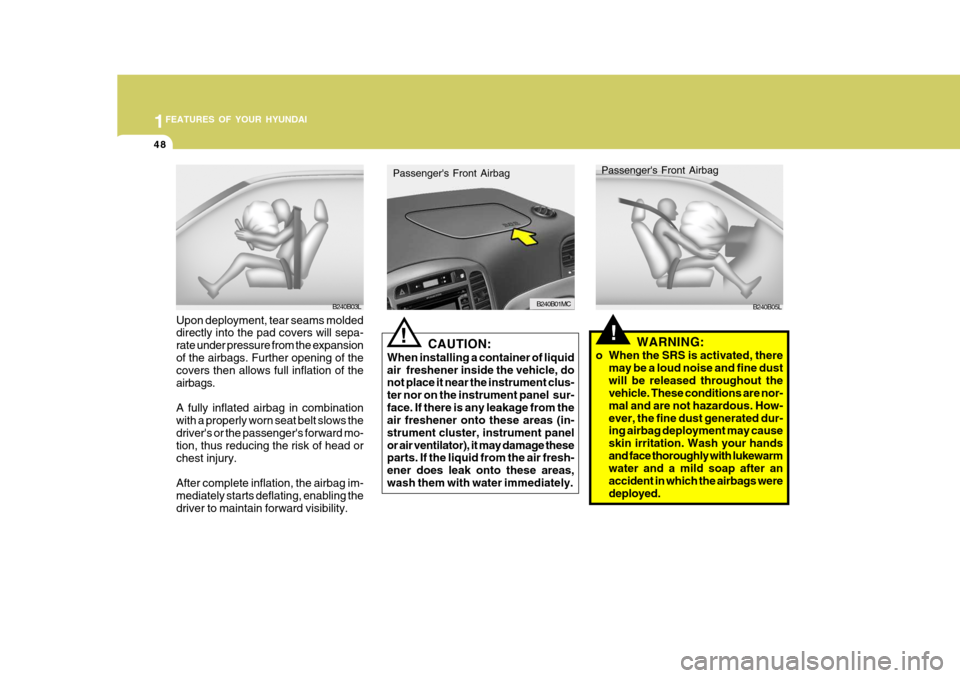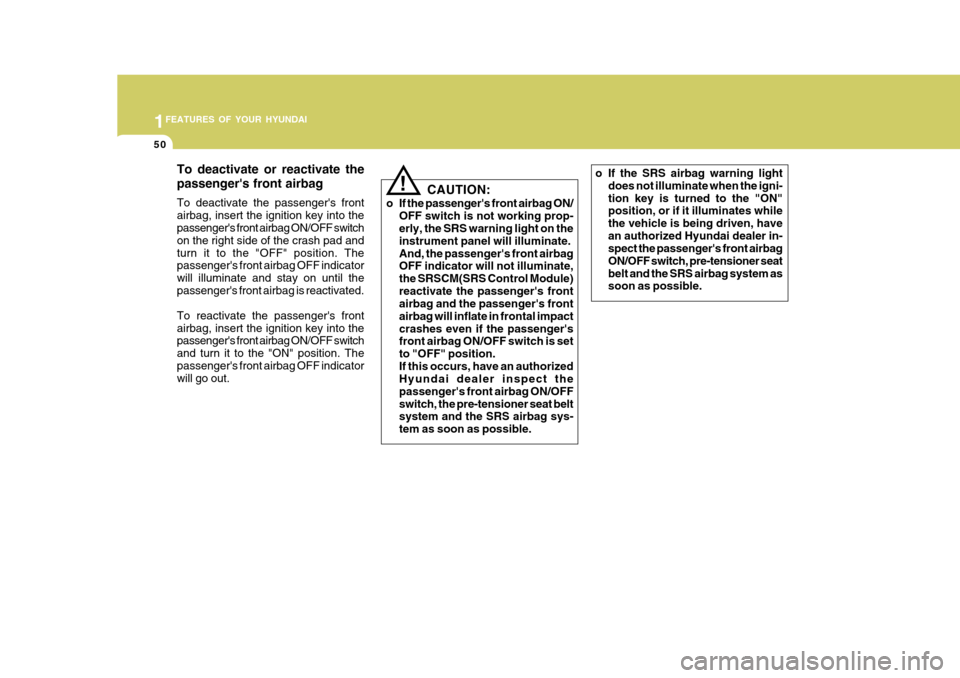2010 Hyundai Accent belt
[x] Cancel search: beltPage 58 of 284

1FEATURES OF YOUR HYUNDAI
46
o Do not allow children to ride in the
front passenger seat. If older chil- dren (teenagers and older) must ride in the front seat, make surethey are always properly belted and that the seat is moved back as far as possible.
o For maximum safety protection in all types of crashes, all occupantsincluding the driver should alwayswear their seat belts whether or not an airbag is also provided at their seating position to minimize the risk of severe injury or death in the event of a crash. Do not sit orlean unnecessarily close to the airbag while the vehicle is in mo- tion.
o The SRS airbag system must de- ploy very rapidly to provide pro-tection in a crash. If an occupant isout of position because of not wearing a seat belt, the airbag may forcefully contact the occupantcausing serious or fatal injuries.o No objects should be placed overor near the airbag modules on the steering wheel, instrument panel,and the front passenger's panel above the glove box, because any such object could cause harmif the vehicle is in a crash severe enough to cause the airbags to deploy.
o If the airbags deploy, they must be replaced by an authorized Hyundaidealer.
o Do not tamper with or disconnect SRS wiring, or other componentsof the SRS system. Doing so could result in injury, due to acci- dental firing of the airbags or byrendering the SRS inoperative.
o Do not install a child restraint sys-
tem in the front passenger seatposition. A child restraint system must never be placed in the front seat. The infant or child could beseverely injured or killed by an airbag deployment in case of an accident.
o Front airbags are not intended todeploy in side-impact, rear-impact or rollover crashes. In addition, airbags will not deploy in frontal crashes below the deploymentthreshold speed.
o The driver should sit back as far as possible while still maintaining control of the vehicle. If you are sitting too close to the airbag, itcan cause death or serious injury when it inflates.
B240A02MC
Rear impact
Side Impact Rollover
Page 60 of 284

1FEATURES OF YOUR HYUNDAI
48
!WARNING:
o When the SRS is activated, there may be a loud noise and fine dust will be released throughout the vehicle. These conditions are nor- mal and are not hazardous. How-ever, the fine dust generated dur- ing airbag deployment may cause skin irritation. Wash your handsand face thoroughly with lukewarm water and a mild soap after an accident in which the airbags weredeployed.
Passenger's Front Airbag
B240B05L
!CAUTION:
When installing a container of liquid air freshener inside the vehicle, do not place it near the instrument clus- ter nor on the instrument panel sur-face. If there is any leakage from the air freshener onto these areas (in- strument cluster, instrument panelor air ventilator), it may damage these parts. If the liquid from the air fresh- ener does leak onto these areas,wash them with water immediately.
Passenger's Front Airbag
B240B01MC
Upon deployment, tear seams molded directly into the pad covers will sepa- rate under pressure from the expansionof the airbags. Further opening of the covers then allows full inflation of the airbags. A fully inflated airbag in combination with a properly worn seat belt slows thedriver's or the passenger's forward mo- tion, thus reducing the risk of head or chest injury. After complete inflation, the airbag im- mediately starts deflating, enabling thedriver to maintain forward visibility.B240B03L
Page 62 of 284

1FEATURES OF YOUR HYUNDAI
50
o If the SRS airbag warning lightdoes not illuminate when the igni- tion key is turned to the "ON" position, or if it illuminates while the vehicle is being driven, havean authorized Hyundai dealer in- spect the passenger's front airbag ON/OFF switch, pre-tensioner seatbelt and the SRS airbag system as soon as possible.
! CAUTION:
o If the passenger's front airbag ON/ OFF switch is not working prop- erly, the SRS warning light on the instrument panel will illuminate.And, the passenger's front airbag OFF indicator will not illuminate, the SRSCM(SRS Control Module)reactivate the passenger's front airbag and the passenger's front airbag will inflate in frontal impactcrashes even if the passenger's front airbag ON/OFF switch is set to "OFF" position.If this occurs, have an authorized Hyundai dealer inspect the passenger's front airbag ON/OFFswitch, the pre-tensioner seat belt system and the SRS airbag sys- tem as soon as possible.
To deactivate or reactivate the passenger's front airbag To deactivate the passenger's front airbag, insert the ignition key into the passenger's front airbag ON/OFF switch on the right side of the crash pad andturn it to the "OFF" position. The passenger's front airbag OFF indicator will illuminate and stay on until thepassenger's front airbag is reactivated. To reactivate the passenger's front airbag, insert the ignition key into the passenger's front airbag ON/OFF switch and turn it to the "ON" position. The passenger's front airbag OFF indicator will go out.
Page 63 of 284

1
FEATURES OF YOUR HYUNDAI
51
B990B01MC-AAT Side Impact Airbag (If Installed) Your Hyundai is equipped with a side impact airbag in each front seat. The purpose of the airbag is to provide thevehicle's driver and/or the front passen- ger with additional protection than that offered by the seat belt alone. The sideimpact airbags are designed to deploy only during certain side impact colli- sions, depending on the crash severity,angle, speed and point of impact. The side impact airbags are not designed to deploy in all side impact situations.
B990B02LZ
o Even though your vehicle is equipped with the passenger's airbag ON/OFF switch, do not in-stall a child restraint system in the front passenger's seat. A child re- straint system must never beplaced in the front seat. Children who are too large for child re- straint systems should alwaysoccupy the rear seat and use the available lap/shoulder belts. Chil- dren are afforded the most safetyin the event of an accident when they are restrained by a proper restraint system in the rear seat.
o As soon as deactivation is no longer needed, reactivate the frontpassenger's airbag.!WARNING:
o The driver is responsible for the proper position of the passenger's front airbag ON/OFF switch.
o Deactivate the front passenger's
airbag only when the ignitionswitch is switched off, or the mal- function may occur in the SRSCM (SRS Control Module). And theremay be a danger that the driver's and/or passenger's front and/or side and curtain airbag may fail totrigger, or not trigger correctly during a collision.
o Never install a rearward facing
child seat on the front passenger'sseat. The infant or child could be severely injured or killed by anairbag deployment in case of an accident.
Page 64 of 284

1FEATURES OF YOUR HYUNDAI
52
!o Use of seat covers could reduce or
prevent the effectiveness of the system.
o Do not install any accessories on the side or near the side impactairbag.
o Do not use excessive force on the side of the seat.
o Do not place any objects over the
airbag or between the airbag and yourself.
o Do not place any objects (an um-
brella, bag, etc.) between the frontdoor and the front seat. Such ob- jects may become dangerous pro-jectiles and cause injury if the supplemental side impact airbag inflates.
o To prevent unexpected deploy- ment of the side impact air bagthat may result in personal injury,avoid impact to the side impact airbag sensor when the ignition key is on.
WARNING:
o The side impact airbag is supple- mental to the driver's and the passenger's seat belt systems and is not a substitute for them. There-fore your seat belts must be worn at all times while the vehicle is in motion.The airbags deploy only in certain side impact conditions severe enough to cause significant injuryto the vehicle occupants.
o For best protection from the side
impact airbag system and to avoid being injured by the deploying side impact airbag, both front seatoccupants should sit in an upright position with the seat belt proper- ly fastened. The driver's handsshould be placed on the steering wheel at the 9:00 and 3:00 o'clock positions. The passenger's armsand hands should be placed on their laps.
o Do not use any accessory seat covers.
B990B01MC
Side airbag sensor
Important Safety Notes on the Side Impact Airbag system Following are a number of safety points concerning this system which shouldalways be observed to ensure risk of injury is reduced in an accident.
Page 69 of 284

1
FEATURES OF YOUR HYUNDAI
57
1. Tachometer
2. Turn Signal Indicator Lights
3. High Beam Indicator Light
4. Automatic Transaxle Position Indicator Light (If Installed)
5. Odometer/Trip Odometer/Trip Computer (If Installed)
6. Overdrive Off Indicator Light (Automatic Transaxle only)
7. Speedometer
8. Fuel Filter Warning Light (Diesel only)
9. Diesel Pre-heat Indicator Light (Diesel only)
10. Passenger's Front Airbag OFF Indicator Light (If Installed)
11. Over Speed Warning Light (If Installed)
12. Door Ajar Warning Light
13. Charging System Warning Light 14. Parking Brake/Low Brake Fluid Level Warning Light
15. SRS (Airbag) Warning Light (If Installed)
16. Seat Belt Warning Light
17. Fuel Gauge
18. Engine Coolant Temperature Warning Light
19. Low Oil Pressure Warning Light
20. Low Fuel Warning Light
21. Immobilizer Warning Light (If Installed)
22. Trunk Lid/Tail Gate Open Warning Light
23. Malfunction Indicator Light (MIL) (If Installed)
24. Electronic Power Steering Warning Light (If Installed)
25. ABS Service Reminder Indicator Light (If Installed)
26. Electronic Stability Program (ESP) Indicator Lights
(If Installed)
Page 71 of 284

1
FEATURES OF YOUR HYUNDAI
59
1. Tachometer
2. Turn Signal Indicator Lights
3. Low Oil Pressure Warning Light
4. Automatic Transaxle Position Indicator Light (If Installed)
5. Odometer/Trip Odometer
6. SRS (Airbag) Warning Light (If Installed)
7. Malfunction Indicator Light (MIL) (If Installed)
8. Speedometer
9. Fuel Filter Warning Light (Diesel only)
10. Diesel Pre-heat Indicator Light (Diesel only)
11. Passenger's Front Airbag OFF Indicator Light (If Installed)
12. Over Speed Warning Light (If Installed)
13. Door Ajar Warning Light 14. Charging System Warning Light
15. Parking Brake/Low Brake Fluid Level Warning Light
16. Seat Belt Warning Light
17. High Beam Indicator Light
18. Fuel Gauge
19. Engine Coolant Temperature Warning Light
20. Overdrive Off Indicator Light (Automatic Transaxle only)
21. Low Fuel Warning Light
22. Immobilizer Warning Light (If Installed)
23. Trunk Lid/Tail Gate Open Warning Light
24. Electronic Power Steering Warning Light (If Installed)
25. ABS Service Reminder Indicator Light (If Installed)
26. Electronic Stability Program (ESP) Indicator Lights
(If Installed)
Page 75 of 284

1
FEATURES OF YOUR HYUNDAI
63
B260J01S-GAT Charging System Warning Light
The charging system warning light should come on when the ignition isturned on, then go out when the engine is running. If the light stays on while the engine is running, there is a malfunctionin the electrical charging system. If the light comes on while you are driving, stop, turn off the engine and checkunder the hood. First, make certain the generator drive belt is in place. If it is, check the tension of the belt.And then, have the system checked by your Hyundai dealer.
CAUTION:
If the drive belt (generator belt) is loosen, broken, or mission while the vehicle is driving, there may be a serious malfunction, engine couldoverheat because this belt also drives the water pump.!
Warning Light Operation The parking brake/brake fluid level warn- ing light should come on when the parking brake is applied and the ignition switch is turned to "ON" or "START".After the engine is started, the light should go out when the parking brake is released.If the parking brake is not applied, the warning light should come on when the ignition switch is turned to "ON" or"START", then go out when the engine starts. If the light comes on at any other time,you should slow the vehicle and bring it to a complete stop in a safe location off the roadway. The brake fluid level warn-ing light indicates that the brake fluid level in the brake master cylinder is low and hydraulic brake fluid conforming toDOT 3 or DOT 4 specifications should be added. After adding fluid, if no other trouble is found, the car should beimmediately and carefully driven to a Hyundai dealer for inspection. If further trouble is experienced, the vehicleshould not be driven at all but taken to a dealer by a professional towing ser- vice or some other safe method. Your Hyundai is equipped with dual- diagonal braking systems. This means you still have braking on two wheelseven if one of the dual systems should fail. With only one of the dual systems working, more than normal pedal traveland greater pedal pressure are required to stop the car. Also, the car will not stop in as short a distance with only halfof the brake system working. If the brakes fail while you are driving, shift to a lower gear for additional engine brak-ing and stop the car as soon as it is safe to do so.